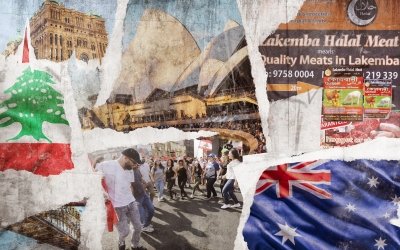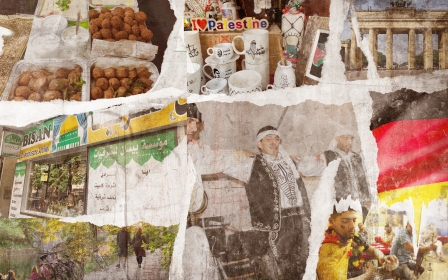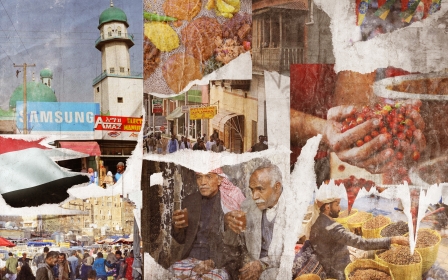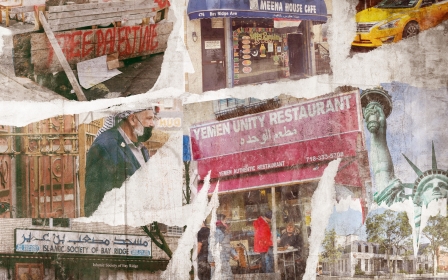From traders to president: Inside Brazil's vast Lebanese community

In the beating heart of the Brazilian metropolis of Sao Paulo lies the chaotic, bustling Rua 25 de Marco.
This wide avenue is flanked by a mix of eclectic businesses, restaurants, and shops that attract thousands of customers.
But the busy street is also one of the main focal points of the country’s vast Lebanese community, as evidenced by the number of Lebanese and Arab restaurants dotted throughout the surrounding area.
Their presence is not the result of contemporary globalisation, or the city’s modern cosmopolitan nature. Instead, the roots of this community - and the impact it has had on the city - lies further back in history.
Such is the case with Raful, one of the many Lebanese restaurants found along the 25 de Marco. It was founded in 1960 by two brothers, Tannous and Raffoul Doueihi, shortly after they arrived from Lebanon.
New MEE newsletter: Jerusalem Dispatch
Sign up to get the latest insights and analysis on Israel-Palestine, alongside Turkey Unpacked and other MEE newsletters
Raful – like many other popular Lebanese restaurants across the city – now boasts a number of different locations across Sao Paulo, reflecting the popularity of Lebanese food, the entrepreneurship of many Lebanese migrants, and the high degree of social and cultural integration the diaspora enjoys in Brazil.
A large diaspora with deep roots
To understand the size and impact of the Lebanese diaspora, one must look back as far as the late 19th century, when the first wave of Levantine migration arrived on Brazilian shores.
In the late 1870s, approximately 150,000 migrants came from parts of modern-day Lebanon and Syria in search of a better future.
“At the end of the 19th century Lebanon was going through a very severe economic crisis,” Diogo Bercito, a Brazilian journalist and scholar specialising in Arab migration to Brazil, tells Middle East Eye.
“The economy was mostly based on exporting silk, mostly to France, and that market collapsed. So, at the end of the 19th century people from what became Lebanon started migrating to Brazil.”
And they didn’t stop arriving. Nowadays, the Lebanese community in Brazil is estimated to number between seven and 10 million people, according to the Ministry of Foreign Affairs. If accurate, this means that there are now more people originally from Lebanon in Brazil than in Lebanon itself.
The Lebanese who arrived in the late 19th century were predominantly Christians who were fleeing the Muslim-majority Ottoman Empire that dominated much of the Middle East at the time. As such, many of the first migrants were originally registered as ‘Turks’ upon arriving in Brazil.
'Brazil was seen as a very stable country. It was seen as a place that had a lot of resources to be explored'
- Diogo Bercito, journalist
They settled predominantly in the states of Sao Paulo, Rio de Janeiro, Minas Gerais, Para, and Goias.
“Brazil was quite an attractive destination at that point," says Bercito. "There is this understanding that most people would want to end up in Europe or the US, but Brazil had had a very peaceful transition from monarchy to republic, which was very different from what happened in other places in the region.
“Brazil was seen as a very stable country. It was seen as a place that had a lot of resources to be explored.”
Industrial integration and economic growth
The diaspora’s integration and influence on Brazilian culture and society was a gradual process, largely driven by graft and ingenuity. Migrants arriving from Europe had a leg up on their Levantine counterparts as many arrived with pre-established work agreements and were able to settle on farms.
Because of this, migrants from modern-day Lebanon and Syria ignored agriculture and opted instead to focus on trade, establishing themselves as "mascates" – or peddlers. They travelled the country selling a variety of goods, often voyaging to remote areas, and working up to 20-hour days.
Within two generations Levantine migrants had begun to dominate this trade, and by 1895 Syrians, Lebanese, and Palestinians represented 90 percent of peddlers in Sao Paulo.
Eventually, Lebanese migrants shifted their focus onto commerce, with a particular focus on the textile industry where they again found success.
“Syrian and Lebanese migrants energised popular commerce by popularising ideas like selling in installments or selling in bulk,” Bercito says. “Those were perhaps practices that didn't exist as such in Brazil, it was very impactful.”
Evidently so, as by 1907 retail and dry goods made up 80 percent of Sao Paulo’s Arab-owned businesses.
From ‘peddlers’ to presidents
But the Lebanese community’s influence wasn’t limited to trade and commerce; they also had an impact on Brazil's intellectual and social development as well.
“There were also a lot of intellectuals and journalists that came at the turn of the century, it was actually a very varied community. Of course, they got associated with peddling and with commerce, but that was not the only thing they did,” Bercito says.
As the Lebanese community became more important and more integrated, a remarkably vibrant journalistic scene also emerged to cater to the diaspora. Between 1880 and 1929 there were as many as 95 Arabic publications across Brazil – compared to only 82 being published in Palestine at the same time.
After gaining more of an economic foothold in Brazil the Lebanese community also began to channel their newfound wealth into upward social mobility.
“The communities initially involved in commerce ended up directing their children towards liberal professions and to the areas of industry and construction," Assad Frangieh, a Lebanese-Brazilian and president of the Lebanese Union of Brazil, tells MEE. "Gradually, the community laid roots in all directions and contributed to the modernisation of Brazilian society.”
This social ascent culminated in the presence of Lebanese-Brazilians in national politics. The former president, Michel Temer, is of Lebanese ancestry, as is the former mayor of Sao Paulo, Fernando Haddad, and former governor, Paulo Maluf, among others.
At one point, 10 percent of Brazil’s congress members were of Lebanese descent.
“Upon effectively participating in the construction of a nation, the marks of the Lebanese characteristics are seen in habits, values, and daily cuisine,” Frangieh says.
Culinary prominence
But perhaps the most enduring and tangible impact the Lebanese have had in Brazil is more pedestrian and accessible than politics: its culinary influence.
'No one would think they're having ethnic food, it became Brazilian'
- Diogo Bercito, journalist
“The most visible [impact], is food," Frangieh says. "We have a very interesting situation in which some of the dishes that we would consider Lebanese or Syrian, like kibbeh, tabbouleh, or sfiha, are staples in Brazil - we eat them very often.
“You don't need to go to a Lebanese restaurant to have a kibbeh, you could go to the bar on the corner. No one would think they're having ethnic food, it has become Brazilian,” Bercito explains.
Lebanese chef Georges Barakat is part of a newer wave of Lebanese migrants, having arrived in Brazil 18 years ago. Despite being trained as a mechanical engineer, he has now established himself as a chef in Sao Paulo due to the lack of opportunities on offer in his native Lebanon.
“I really like going back to my roots. Cuisine is a way for us Lebanese – even those who weren’t born there – to maintain ties with our ancestors. Cooking, this is a connection with our roots, a connection with our ancestry, a connection with one’s parents,” he tells MEE.
The culinary impact is evident way beyond the 25 de Marco street and specialised restaurants. One of Brazil's most popular fast food choices is an Arab chain by the name of Habib’s, which sells about 600 million sfiha pies a year.
The history and influence of the Lebanese diaspora have generated a sense of pride within Frangieh.
“Brazil is the home that offers you citizenship, respect, dignity, and future, while Lebanon offers an understanding of one’s cultural, religious, and human roots, and values," he says.
"It is very gratifying to be Brazilian, to have Brazilian children, and at the same time to recognise your Lebanese-Arab roots.”
This article is part of a series. To find out more about other Middle Eastern communities around the world, stay tuned for the next piece, due to be published next week.
This article is available in French on Middle East Eye French edition.
Middle East Eye delivers independent and unrivalled coverage and analysis of the Middle East, North Africa and beyond. To learn more about republishing this content and the associated fees, please fill out this form. More about MEE can be found here.








